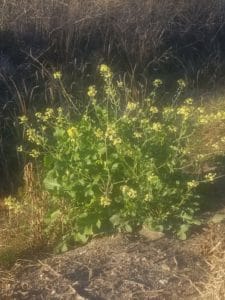First off, I wish all of you a happy holiday season.
 As for my bees, they are pretty much “put to bed” for the winter. I say “pretty much”, because here in the Deep South, most days include at least some weather that is suitable for bee flight. Fortunately, there is always something for the bees to find. Just now, wild mustard is in bloom, and pretty soon red maple and dandelion will come. If you’ve never seen wild mustard, I’ve attached a photo of the plant (picture taken December 16).
As for my bees, they are pretty much “put to bed” for the winter. I say “pretty much”, because here in the Deep South, most days include at least some weather that is suitable for bee flight. Fortunately, there is always something for the bees to find. Just now, wild mustard is in bloom, and pretty soon red maple and dandelion will come. If you’ve never seen wild mustard, I’ve attached a photo of the plant (picture taken December 16).
Since my bees are active all year, I don’t have to worry about mouse guards, Nosema, or similar winter preparations. Two of my colonies were light on feed; they got 2/1 feed.
One of the colonies being fed gave me a reminder on basic beekeeping safety rules: wearing a veil is mandatory when working with an open hive. In this case, I thought I could change out a feed pail without getting my veil on; after all, I wasn’t going to remove the inner cover in the process. Well, when I removed the empty feeder, one of the bees in that colony rushed out and stung me on the eyelid – not a fun place to get stung. Fortunately, I didn’t have any serious damage, but Mary and I had a social engagement with my ophthalmologist the next day. The embarrassment of showing up there with a swollen eyelid helped drive home the message that one neglects basic safety rules at one’s own peril.
On the subject of 2/1 feed: the stuff can crystallize in the feeder during a cool period, and the crystals can keep the bees from being able to get to the feed. If you find that your bees are not taking feed, check your feeder for crystallization. Fortunately, the cure is simple: drain the feeder liquid and crystals into a pot, then heat and dissolve the crystals. Your feed is then ready to put back in the feeder, and the feeder replaced on the hive.
While I don’t like to do extensive open hive work during the winter, this year 10 of my colonies will be getting formic acid (Miteaway Quick Strip®) treatments (assuming, of course, their mite counts say the treatment is needed). This is a new product for me. The beekeepers that I talked to out in Colorado this summer thought highly of formic acid as a mite control agent, even though it is hardly mentioned in the seminars around here. I’ll be taking mite counts (sticky board) before and after the treatments, and I’ll share the results with you.
Speaking of seminars, a good one is coming up: our annual Alabama Cooperative Extension Service Beekeeping Symposium will be on February 3. I don’t know how Jim Tew packs so much information into a day, but he does year after year. Should you be in the area (business trip to Huntsville or Birmingham, perhaps?), this seminar is a great way to spend a winter Saturday. If you want more information, the website is http://www.aces.edu/home-garden/beekeeping/.
And that’s the news from the South for December.
-Bill Miller
